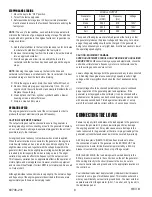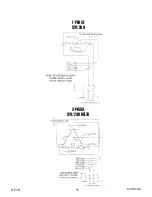
6
REV B
60706-231
GASOLINE
When using gasoline, always use fresh, clean, unleaded fuel. The
engine is certified to operate on unleaded gasoline with a minimum
octane rating of 87 or higher. Gasoline containing no more the 10%
ethanol is acceptable.
CAUTION: EQUIPMENT DAMAGE
Do not use unapproved gasolines, such as E15 or E85. Do not mix
oil in the gasoline. Use of unapproved fuels will damage the engine
compenents and void the engine warranty.
Use of fuels with content of ethanol greater than shown above may
cause starting and/or performance problems. Always ensure that the
fuel is clean and free of all impurities.
WARNING: FIRE DANGER
Gasoline and its fumes are VERY explosive when proper precautions
are not taken.
Never use gasoline that has been stored for an extended period of
time as the fuel will lose its volatile properties and you will be left with
varnish residue. The varnish like substance will clog the carburetor and
will not burn properly.
The use of fuel additives, such as Sta-Bil, or an equivalent will minimize
the formation of fuel gum deposits. If a unit has been out of operation
for an extended period of time, it is best to drain old fuel from the
engine and replace with fresh fuel before attempting to start.
FUEL SUPPLY
The EC units provide flexibility in where they get gasoline from.
Whether you are using our optional fuel tank, or supplying your own,
there are some important factors to consider. The fuel pump on the unit
is only capable of about 30” of lift in ideal circumstances. Tank size,
tank location, hose size, hose routing, and hot spots all play a role in
a successful fuel tank installation. Preferred fuel installations use 1/4”
hose that run straight to the engine with no drops or twists from an
adequately (15 gallons) sized fuel tank.
1. The fuel lift from the bottom of the tank to the fuel outlet on the
generator must not exceed 30”. If a greater lift is required, it
may be necessary to provide an additional electric fuel pump to
ensure the engine get a sufficient flow of fuel.
2. EPA regulations require the installation of a carbon canister on the
tank vent line. This is to prevent the escape of fuel vapors in to
the
atmosphere.
3. You need to have a primer bulb in the fuel line to prime the fuel
from the tank to the fuel pump. The vacuum fuel pump on the
engine will not draw the fuel up from the tank until the line has
been properly primed.
4. In all cases the minimum fuel line size must be 1/4” or larger line.
And the fuel line must be certified for use with unleaded gasoline.
LUBRICATION
Before starting the engine, fill the crankcase to the proper level with
a good quality oil. The recommended grade oil and quantity of oil
required is listed in the engine operator’s manual and under the service
tab in this manual. This unit was shipped with most of the oil removed.
The engine normally holds 78 - 80 oz (2.4 - 2.5 qts) of oil. Since there
is some trapped in the engine, when filling the crankcase the first time,
use the dipstick to ensure that you do not over fill the crankcase. The
full oil level mark on the dipstick is depicted in the following image.
Oil is added to the engine by removing the oil cap and adding oil at
this point. After filling the crankcase to the proper level, be sure you
properly tighten the oil fill cap.
NOTE: This engine generator must be on a level surface before you
check or add oil to the system.
The necessity of using the correct oil and keeping the crankcase full
cannot be overemphasized. Engine failures resulting from inadequate
or improper lubricant are considered abuse and not covered by the
generator or engine manufacturer’s warranty.
OIL RECOMMENDATIONS
Outdoor temperatures determine the proper oil viscosity for the
engines. Use the chart to select the best viscosity for the outdoor
temperature range expected.
OIL ALERT SYSTEM
This generator is equipped standard with the Briggs & Stratton low oil
pressure shutdown system. The low oil shutdown system is designed


































